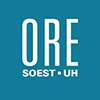To subscribe to the ORE seminar mailing list, click here.
For a (working draft) list of upcoming seminars, click here.
If you are interested in giving an ORE seminar, please contact us at nosal [at] hawaii [dot] edu.

- This event has passed.
Seminar: Using Distributed Acoustic Sensing to observe surface gravity waves and nearshore processes
8 February 2023 @ 3:30 pm - 4:30 pm
Dr. Hannah Glover, Postdoctoral Scholar
Dr. Meagan Wengrove, Assistant Professor of Coastal Engineering
College of Engineering, School of Civil and Construction Engineering
Oregon State University|
Location Information
**This seminar will be held both in person (Watanabe Hall 112) and over Zoom**
Meeting ID: 961 6222 2366
Passcode: OREseminar
https://hawaii.zoom.us/j/96162222366
Distributed acoustic sensing (DAS) uses an interrogator to send pulses of laser light down fiber optic telecommunications cables. The coherent backscattered return of light from impurities in the manufactured glass to the interrogator can be used to sense environmental signal. Phase shifts in the backscattered light are directly related to cable deformation. Here, we explore the use of DAS technology as an ocean bottom sensor on submerged cables in the nearshore coastal ocean. The nearshore is the region where the ocean meets land, waves of varying period shoal, are reflected from shore, and cause currents. Signal measured with DAS has been shown to be capable of observing the aforementioned coastal processes, but up until now, the analysis has been mostly qualitative. Ocean bottom DAS technology has many applications, most notably, it is an in-situ ocean sensor that provides a distributed spatial array of measurements along the cable length, making it the highest temporal and most spatially dense ocean bottom sensor. DAS technology could be used for an early warning system for events such as sneaker waves, and could also be used to measure forces imposed on the ocean bottom over many hundreds of meters. We present results from both a laboratory study and a field studies where we investigate a transfer function from DAS inferred cable strain to ocean bottom dynamic pressure. In the laboratory experiment, performed at the O.H. Hinsdale Wave Research Laboratory, we deploy 50 m long cable sections along with bottom pressure sensors and wave gages co-located with DAS channels. We measure signal in monochromatic wave conditions as well as under spectra of wave forcing. During the field experiments, located in Duck, NC at the USACE Army Corps Field Research Facility, we deploy at 1500 m long cable in the cross shore and compare signal measured with DAS to co-located in-situ and remotely sensed instruments. We will also show preliminary results from the Kilo-Nalu cable in Honolulu. Results show that a transfer function between ocean bottom dynamic pressure and measured strain from the cable may be power-law related and dependent on cable buffering.
